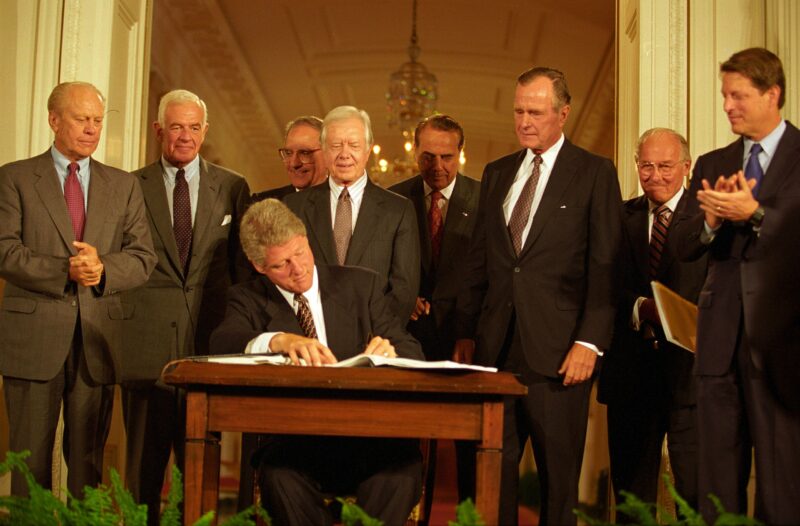NAFTA: 30 Years of Driving Free Trade Critics Crazy

Almost since its inception, the North American Free Trade Agreement has generated controversy far out of proportion to its economic consequences. From Ross Perot’s 1992 warning that NAFTA would create a “giant sucking sound” of jobs flowing to Mexico to Barack Obama’s (and Hillary Clinton’s) campaign trail threat to pull out of the agreement to Donald Trump’s 2016 description of it as a “disaster,” criticism of the trade deal has been a near-constant feature of American politics.
Veracity aside, such swipes are curious. The agreement signed among Mexico, Canada, and the United States — building on a pre-existing free trade deal between the latter two — was never going to significantly alter the United States’ economic trajectory. It just wasn’t possible. Eliminating US tariffs on imports from a single, relatively smaller country already facing very low tariffs — an average of two percent — isn’t the stuff that economic game-changers are made of.
Perhaps, then, NAFTA is best understood as a lightning rod for criticism of globalization more broadly. Ire directed at the agreement is as much aimed at trade conceptually as it is at NAFTA itself, if not more so.
It is in this spirit that one best understands Helen Andrews’ recent critique of NAFTA in The American Conservative to mark the agreement’s 30th birthday. While Andrews, a senior editor at The American Conservative, directs several barbs at the trade deal, her main beef is the era of globalization she holds NAFTA responsible for helping usher in.
In Andrews’ telling, NAFTA was merely the first of several important free trade dominos to fall, setting off a “chain of events that allowed globalization to run free the way it did.” NAFTA’s entrance into force on January 1, 1994, she notes, was accompanied around the same time by other important milestones of expanded economic integration including the agreement creating the World Trade Organization, the formation of the European Union, and the opening of the Chunnel connecting the United Kingdom and France.
Boom, globalization was off to the races.
But the idea that 1994 heralded a new economic era is a strained interpretation of events. Put more bluntly, it’s false. Globalization — the process of increasing international economic integration—has been underway for centuries, if not millennia. (The first evidence of long-distance trade dates back to 3000 BCE) Sometimes it has ebbed (the outbreak of the world wars) and other times it has flowed (the Age of Discovery and the Industrial Age) but the direction has long been toward more expanded linkages. Indeed, each of the items cited by Andrews weren’t revolutionary events but further evolutions of events long underway.
The European Union, for example, was the successor to the European Community, which in turn traces its origins to the European Coal and Steel Community. The World Trade Organization, meanwhile, was preceded by the General Agreement on Tariffs and Trade (GATT), which had successfully reduced tariffs around the world through a series of negotiating rounds spanning many decades. Before the Channel Tunnel’s opening, commerce between the UK and its European neighbors took place via shipping and airplanes (and still does). And prior to NAFTA, there was the US-Canada Free Trade Agreement signed in 1988. Globalization has long been apace.
Andrews also errs in other elements of her narrative about globalization’s forward march. While she holds neoconservatives responsible for Republicans’ 1990s-era departure from their traditional pro-tariff stance and Ronald Reagan’s “nuanced and pragmatic” trade policies, she ignores that NAFTA was in many ways the realization of a vision first outlined by Reagan.
In Reagan’s 1979 announcement of his candidacy for president, he called for a “North American accord” — incorporated into the 1980 GOP platform — to develop closer ties among the United States, Canada, and Mexico. While the exact contours of this proposal were not spelled out, Reagan mentioned in his speech his dream of a future in which “a map of the world might show the North American continent as one in which the people’s commerce of its three strong countries flow more freely across their present borders than they do today.”
There’s also the small matter that the US-Canada free trade agreement that served as NAFTA’s foundation was signed by Reagan in 1988. Hardly a neoconservative, Reagan was arguably NAFTA’s intellectual godfather.
This miscasting of history, however, is a relatively minor detail. More notable is the thin nature of Andrews’ NAFTA criticism, which consists as much of promises unfulfilled as actual harms inflicted. She claims, for example, that Mexicans imported their goods from Asia instead of the US (in fact, US exports to Mexico more than doubled from 1994-2000), and points out that a bilateral trade balance that had been in US surplus swung to a deficit (an irrelevant measure of economic success). NAFTA’s immediate wake also saw an “explosion” of illegal immigration, “much” of which Andrews says — baselessly — the trade deal was “directly responsible for.”
On Mexico’s side of the ledger, meanwhile, she dings the agreement for rising obesity levels in the country, two million campesinos (rural farmers) losing their employment as US corn flooded in and then looking for work across the border, and a rising tide of progressive social policy including abortion, marriage equality, and permitting same-sex couples to adopt (which this author happens to support).
The idea that seismic economic or societal shifts would result from a free trade agreement, however, should be met with considerable skepticism.
Regarding the surge in illegal immigration, for example, it’s worth considering other contemporaneous events. In addition to NAFTA, 1994 also saw the so-called “Tequila Crisis” that plunged Mexico into recession (NAFTA helped facilitate the subsequent recovery). On the US side, the go-go economy of the late 1990s saw unemployment drop below 5 percent from May 1997 through August 2001. That immigration increased under such circumstances should surprise no one.
More relevant when evaluating a free trade agreement are economic outcomes — and from that perspective, NAFTA looks pretty good. From the date of the agreement to the present day, per-capita GDP has nearly doubled in Mexico and almost tripled in the United States, and US manufacturing output, median wages, and median household income have all experienced healthy gains. To be clear, it’s a mistake to single-handedly credit NAFTA with such outcomes — correlation isn’t causation. But the same principle applies to NAFTA’s critics, who often blame the agreement for any and all economic problems since 1994.
Interestingly, even Andrews concedes that the number of jobs lost to Mexico was “relatively small.” But, keeping with her overarching narrative, she nonetheless holds NAFTA culpable for its alleged unleashing of forces that allowed globalization to run riot, contributing to various economic ills, including the loss of 5 million manufacturing jobs from 1995-2015.
But NAFTA’s claimed role is ahistorical, and blame placed on globalization for manufacturing job losses is mistaken. The decline in US manufacturing jobs — something that has been taking place since 1979 — is more a story of technology (robots, computers, and the like) and changing US consumer tastes than it is about trade. We know this because while the number of manufacturing jobs has declined, output has risen. Manufacturing jobs have declined abroad too, even in China. More recent US manufacturing job gains, meanwhile, have been accompanied by stagnant industrial productivity. Most lost manufacturing jobs were claimed by automation and economic development, not Mexico and China.
So what is NAFTA’s real record? Literature on the subject paints a consistent picture: the agreement significantly expanded trilateral trade but had only a modest — and beneficial — economic impact. A 2012 OECD literature review of NAFTA studies generally found small but positive results, as did a 2013 US International Trade Commission (USITC) review. GDP, productivity, and wages increased by modest amounts — economic welfare increased. Another 2014 paper examining NAFTA’s effects produced similar results. Given NAFTA’s scope and the long-established gains of free trade, that’s about what one should expect.
It also bears mentioning that some of the agreement’s benefits are not easily quantifiable. The trade deal, for example, means that Americans now have easier access to out-of-season fruits and vegetables that can be grown in Mexico’s favorable climes. Since the late 1990s the amount of fresh vegetables imported into the United States — primarily from Mexico and Canada — has nearly doubled.
NAFTA has also played a role in bolstering the resilience of the US auto industry at a time of rising global competition, especially from Asia. The elimination of duties between the United States and Mexico has provided additional export opportunities for both US automakers and auto parts producers as well as a more competitive source of crucial inputs. The result: a more competitive North American auto industry, with the United States at its center. Indeed, it is for this reason that the Center for Automotive Research warned in 2017 that Detroit would be hard hit by a US withdrawal from NAFTA.
Admittedly, the removal of trade barriers does produce some disruption, particularly for workers previously insulated from import competition. But some context is in order. The dynamic US economy destroys and creates millions of jobs each year due to technology, trade (both international and interstate), innovation, and other factors. According to a 2014 Peterson Institute for International Economics analysis, however, only 5 percent of the job losses were attributable to trade with Mexico. An economy without job loss, whatever the reason, is an economy locked in stagnation and suffering.
If the United States has been harmed by NAFTA, it is perhaps found in the misplaced attention it receives. Energy devoted to the trade deal’s alleged harm is attention deflected from actual policy missteps. That’s useful to politicians and others for whom NAFTA (and other trade issues) provide a useful distraction from actual sources of economic damage such as overwrought environmental regulations, ballooning infrastructure costs, and protectionist policies that undermine US competitiveness such as tariffs on imported metals and the Jones Act.
Focusing on such realistic threats might roil powerful special interests, so blame is instead assigned to NAFTA and foreign competition.
NAFTA has, overall, produced limited but small benefits for the United States, and 30 years on should be regarded as a modest policy success. Its participants have, on net, benefitted from the deal. Three decades on, its critics should finally sheathe their rhetorical swords and move on to actual economic challenges facing the country.











